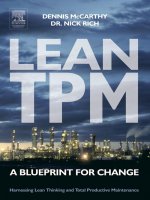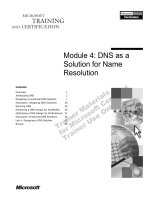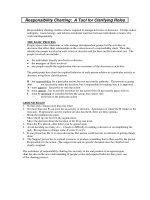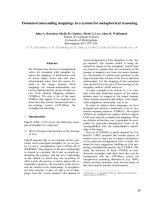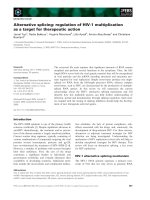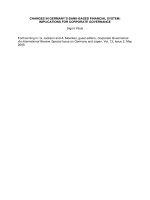A Blueprint for Corporate Governance docx
Bạn đang xem bản rút gọn của tài liệu. Xem và tải ngay bản đầy đủ của tài liệu tại đây (1.4 MB, 240 trang )
A Blueprint for
Corporate Governance
AMACOM
AMERICAN MANAGEMENT
ASSOCIATION
Fred R. Kaen
A Blueprint
for
Corporate
Governance
9818$$ $$FM 12-09-02 08:28:40 PS
9818$$ $$FM 12-09-02 08:28:41 PS
This Page Intentionally Left Blank
A Blueprint
for
Corporate
Governance
Strategy, Accountability,
and the Preservation of
Shareholder Value
Fred R. Kaen
American Management Association
New York • Atlanta • Brussels • Buenos Aires • Chicago • London • Mexico City
San Francisco • Shanghai • Tokyo • Toronto • Washington, D. C.
9818$$ $$FM 12-09-02 08:28:42 PS
Special discounts on bulk quantities of AMACOM books are
available to corporations, professional associations, and other
organizations. For details, contact Special Sales Department,
AMACOM, a division of American Management Association,
1601 Broadway, New York, NY 10019.
Tel.: 212-903-8316. Fax: 212-903-8083.
Web site: www.amacombooks.org
This publication is designed to provide accurate and authoritative
information in regard to the subject matter covered. It is sold with
the understanding that the publisher is not engaged in rendering
legal, accounting, or other professional service. If legal advice or other
expert assistance is required, the services of a competent professional
person should be sought.
Library of Congress Cataloging-in-Publication Data
Kaen, Fred R.
A blueprint for corporate governance : strategy, accountability, and the
preservation of shareholder value / Fred R. Kaen.
p. cm.
Includes bibliographical references and index.
ISBN 0-8144-0586-X
1. Corporate governance. 2. Corporate governance—United States. I. Title.
HD2741 .K327 2003
658.4—dc21 2002014162
᭧ 2003 Fred R. Kaen.
All rights reserved.
Printed in the United States of America.
This publication may not be reproduced,
stored in a retrieval system,
or transmitted in whole or in part,
in any form or by any means, electronic,
mechanical, photocopying, recording, or otherwise,
without the prior written permission of AMACOM,
a division of American Management Association,
1601 Broadway, New York, NY 10019.
Printing number
10987654321
9818$$ $$FM 12-09-02 08:28:42 PS
CONTENTS
Chapter 1: Corporate Governance:
An Overview 1
Introduction 1
The Modern Corporation 2
Civic Republicanism 3
Liberalism 5
The Corporation Complicates the World 6
The Separation of Management and Ownership 8
The Trustee Approach 9
Managerial Capitalism and the Managerial Technocracy 11
The Contractual Shareholder Model 14
Chapter 2: The Governance Structure of
American Corporations 17
A Schematic Contractual Governance Structure 17
The Owners 19
Voting Rights 24
The Board of Directors 25
Corporate Executives and Senior Managers 26
Creditors 27
Relationships With Suppliers and Customers 28
An Organic Version of the Modern Corporation 29
Do Managers Accept the Shareholder Supremacy Model? 31
Chapter 3: Markets: Can You Trust Them? 33
Introduction 33
Financial Market Efficiency 34
Weak-Form Efficiency (Past Prices) 35
v
9818$$ CNTS 12-09-02 08:31:49 PS
vi CONTENTS
Semistrong-Form Efficiency (Public Information) 37
Strong-Form Efficiency 43
Market Inefficiencies and Anomalies 45
IPOs 45
Earnings Announcements 46
The 2000 NASDAQ Crash 47
What Market Efficiency Means for Managers and
Governance 48
How Are We Doing? 48
Don’t Try to Outguess or Beat the Market 50
Don’t Try to Fool Investors 51
Transparency and Market Efficiency 53
Chapter 4: Valuation 57
Introduction 57
Valuing Common Stock 57
Cash Dividends and Earnings 59
Investors’ Required Rate of Return 59
The Capital Asset Pricing Model 62
Does the CAPM Work? 64
Assets in Place Versus Growth Opportunities 65
An Expanded Valuation Model 66
Relative Valuation Using Comparables 70
Chapter 5: Corporate Governance Issues in
Investment Decisions 73
Introduction 73
The NPV Rule 74
A Stylized NPV Example 75
The Data 75
The Present Values 77
Interpreting NPV 78
Do Investors Behave as Predicted by the NPV Rule? 79
Implication of the NPV Rule for Internal Allocation of
Capital 81
9818$$ CNTS 12-09-02 08:31:49 PS
CONTENTS vii
Legitimate and Illegitimate Criticisms of the NPV Rule 82
Strategic Options and the NPV Rule 84
Competitive Analysis Approach 85
Chapter 6: Corporate Governance Issues
and the Financing Decision 89
Introduction 89
The Setup 91
Shareholder/Bondholder Conflicts of Interest 93
The Events 94
How Creditors Protect Themselves with Covenants 95
Shareholder/Manager Conflicts of Interest 96
The Financing Decision and Customers 99
The Financing Decision and Employees 100
Bank Debt Versus Public Debt 101
Does Where You Raise Funds Matter? 103
Chapter 7: Corporate Governance Dividend
Issues 105
Introduction 105
The Setup: Why Pay Cash Dividends? 106
Solving Informational Asymmetry Problems 107
Dividends, Free Cash Flow, and Conflicts of Interest 110
Dividends and Growth Opportunities 110
Dividends and Legal Systems 111
Dividends, Taxes, and Share Repurchases 113
An Example of Disgorging Cash: Ford Motor Company 114
Explicit Free Cash Flow Dividend/Share Repurchase
Policies 115
Chapter 8: Corporate Governance and
Managerial Compensation 117
Introduction 117
The Problem 118
9818$$ CNTS 12-09-02 08:31:50 PS
viii CONTENTS
Measuring Effort and Performance 119
Common Pay and Performance Schemes 121
Base Salary Examples 122
Short-Term Incentive Plans 123
Short-Term Incentive Examples 124
Problems With Short-Term Incentive Plans 125
Problems with Accounting Measures 125
Problems with Budgets 126
Potential Gaming Behavior 127
Long-Term Incentive Plans 128
Examples of Long-Term Incentive Plans 130
Problems with Stock Option and Restricted Stock Plans 130
Reported Earnings and Paying Managers with Stock
or Stock Options 132
Abusive Manipulation of Earnings 134
EVA᭨: A Very Popular Compensation Plan and Corporate
Governance Metric 136
A Stylized EVA Example 137
Using EVA to Set Compensation 140
The Evidence About Pay and Performance 141
Pay and Performance in 2000 142
Chapter 9: The Corporate Control Market 149
Introduction 149
Why a Corporate Control Market? 150
A Restructuring Plan for LeisurePark 151
A Tender Offer for LeisurePark 153
Mergers and Acquisitions 155
United Airlines and US Airways 156
Hewlett-Packard and Compaq 158
When Do Mergers Create Value? 159
How Can Mergers Destroy Shareholder Value? 161
Divestitures, Spin-Offs, and Carve-Outs 162
Going Public: IPOs 164
Why Go Public? 164
LBOs and MBOs 165
Why LBOs and MBOs? 166
Potential Problems for Public Investors 167
9818$$ CNTS 12-09-02 08:31:50 PS
CONTENTS ix
Chapter 10: The Board of Directors and
Shareholders Rights 169
Introduction 169
A Historical Perspective 170
From World War II to the 1970s 170
Boards Again Attract Attention 171
Composition and Compensation of the Board of Directors 172
Board Committees 173
Board Compensation 174
The CEO and the Board Chair 178
Shareholder Rights 178
Voting Rights 179
How Many Votes for Each Shareholder? 179
Confidentiality Issues 180
ERISA and Institutional Investor Voting
Responsibilities 181
Electing the Board of Directors 181
Cumulative Voting 181
Staggered Boards 182
Poison Pills, Supermajority Rules, and Greenmail 183
A Shareholder Rights Plan at First Virginia Banks (FVA) 184
Evidence About Antitakeover Devices 184
Board Governance and Firm Performance 185
Chapter 11: Alternative Governance
Systems: Germany and Japan 187
Introduction 187
The German System 188
German Governing Boards 189
Absence of Corporate Control Market 190
Universal Banking: A German Governance Solution 191
Advantages of Universal Banking 191
Disadvantages of Universal Banking 193
Banks May Care About Firm Survival, Not Share
Price 194
Weak Investor Protection Laws 194
9818$$ CNTS 12-09-02 08:31:51 PS
x CONTENTS
Absence of an Equity Market Hinders Formation of
New Firms 195
What’s the Evidence with Respect to Germany? 196
Why German Firms Adopt an American Governance
Structure 197
The Japanese Keiretsu 199
Reciprocal and Control-Oriented Share Ownership 200
Relational Contracting 202
A Critique of the Keiretsu 204
Advantages of the Keiretsu 204
Disadvantages of the Keiretsu 205
Japanese Reforms 206
Convergence or Diversity? 207
OECD Principles of Corporate Governance 209
Notes 211
Index 215
About the Author 227
9818$$ CNTS 12-09-02 08:31:51 PS
A Blueprint
for
Corporate
Governance
9818$$ HFTL 12-09-02 08:31:52 PS
9818$$ HFTL 12-09-02 08:31:52 PS 9818$$ $$FM 12-09-02 08:28:41 PS
This Page Intentionally Left Blank
CHAPTER 1
CORPORATE
GOVERNANCE:
AN OVERVIEW
INTRODUCTION
C
orporate governance is about who controls corporations
and why. In the United States, the legal ‘‘who’’ is the
owners of the corporation’s common stock—the sharehold-
ers. However, the reality—even the legal reality—is much
more complicated, and the ‘‘why’’ is to be found in historic
American concerns about the connections between owner-
1
9818$$ $CH1 12-09-02 08:32:10 PS
2
AB C G
ship, social responsibility, economic progress, and the role of
markets in fostering a stable pluralistic democracy.
Initially, these concerns were focused on the role and re-
sponsibilities of the owners of business firms because the
owners managed the firms themselves. However, with the
emergence of large corporations, perhaps symbolized by the
Standard Oil Trust in the late nineteenth century, Americans
focused their attention on a new group of individuals: pro-
fessional managers. Prior to the emergence of these corpora-
tions, managers and owners had been the same people, but
now things were changing. Now wealthy and often absentee
owners were hiring managers to run large, powerful compa-
nies, leading to a new set of questions. Among them were:
Who were the managers to represent and why? What were
the managers’ connections to the owners, and what, if any,
were the social responsibilities of the managers and owners?
Could the managers be trusted to carry out whatever eco-
nomic and social objectives were entrusted to them? How
could they be held accountable for their actions? And, how
could they be controlled? In short, what was this beast that
came to be called the modern corporation, who should con-
trol it, and how should it be controlled?
THE MODERN CORPORATION
The modern corporation, a term coined by Adolf Berle and
Gardiner Means, is a limited liability company (limited lia-
bility means that the owners are not personally liable for the
debts or any other legal obligations of the firm) in which
management is separated from ownership and corporate
control falls into the hands of the managers.
1
This separation
of ownership from management and the resulting loss of di-
rect owner involvement in the firm forced many people to
rethink the conventional wisdom about the role of markets
9818$$ $CH1 12-09-02 08:32:11 PS
CORPORATE GOVERNANCE: AN OVERVIEW 3
and the need for private ownership of capital in shaping the
citizens’ sense of civic responsibility, preserving liberty, and
ensuring economic progress. To explain why this occurred,
we need to consider briefly two dominant historical theories
about the importance of property ownership and markets
for ensuring that Americans would live in a free society that
promised equality and fairness for all: civic republicanism
and nineteenth-century liberalism.
2
CIVIC REPUBLICANISM
The term civic republicans describes those who believed that
a strong link existed between property ownership and social-
ly responsible civic behavior. As American thought and
mythology evolved in the eighteenth and nineteenth centu-
ries, many individuals regarded the ownership of property
(land, tools of production, machinery, and so forth) as essen-
tial for motivating individuals to participate in the political
process so as to protect their property from the opportunistic
behavior of others. Essentially, widespread property owner-
ship was seen as a means of promoting social and political
stability by providing a defense against demagogic attempts
to gain control of the political apparatus. Property ownership
was deemed necessary for changing human behavior by giv-
ing people a stake in society.
Because of this important link between property owner-
ship and responsible civic behavior, property ownership be-
came the basis for the political franchise. Furthermore,
citizens’ rights and obligations, including commitments to
the community and relationships to neighbors, were defined
in terms of property ownership. Finally, participation in pol-
itics at the local level was considered to be training for even-
tual civic participation at higher levels—county, state, and
federal.
9818$$ $CH1 12-09-02 08:32:11 PS
4
AB C G
Civic republicans also saw widespread property owner-
ship as a means for achieving liberty and equality. Liberty
meant freedom from tyrants and oligarchs. It meant substi-
tuting the rule of law and the freedom of self-determination—
especially economic self-determination—for dependence on a
ruling class and its benevolent largess. Economic self-
determination, in particular, meant no longer having to
rely on an aristocracy for one’s living or being forced to
‘‘sell’’ one’s labor or services to a landed gentry. Instead,
one could get the highest price for one’slaborandproduc-
tion in the ‘‘market.’’ In other words, it was the market
that made possible the escape from dependency, and so the
market was as essential as property ownership for enabling
individuals to enjoy the benefits of ‘‘life, liberty, and the
pursuit of happiness.’’
Markets facilitated economic freedom by making it possi-
ble for people to secure the just rewards of their labor—
rewards that, in turn, enabled them to become economically
self-sufficient. Markets also enhanced economic efficiency by
allocating resources through an arms-length process in
which social status and class were not particularly important
in determining who had claims on economic wealth, thereby
supporting the ideals of equity and fairness. Markets, in fact,
were class levelers that made the objective of economic
equality attainable. So, property ownership and markets were
inexorably tied to each other as the means for supporting
democracy, liberty, freedom, and socially responsible be-
havior.
But for all this to happen, property ownership had to be-
come and remain widespread. And, equally important, the
markets themselves had to operate efficiently and not be sub-
ject to manipulation—the need for transparency in market
transactions was recognized quite early.
9818$$ $CH1 12-09-02 08:32:11 PS
CORPORATE GOVERNANCE: AN OVERVIEW 5
LIBERALISM
Those who held contrasting views to those of civic republi-
cans were called liberals. These nineteenth-century liberals,
although they also wanted to foster democracy, freedom, and
liberty, were more cynical about human nature than the civic
republicans. The liberals, unlike the civic republicans, did
not believe that you could change human nature through the
marketplace and widespread ownership of property. Individ-
uals would be opportunistic and self-seeking regardless of
whether they owned property, and property ownership in
and of itself would not motivate individuals to become virtu-
ous, socially responsible citizens. Instead, the liberals empha-
sized the creation of institutional structures, procedures, and
governance systems that would fragment or at least discour-
age the concentration of economic and political power and
that would prevent a particular interest group from dominat-
ing and taking advantage of other groups. In other words, in
sharp contrast to the civic republicans, the liberals did not
want to eliminate self-seeking opportunistic behavior—they
saw that as an impossible dream. Instead, they wanted to
harness it and use it to control peoples’ behavior.
But, if the market and property ownership were not
needed for changing human behavior (as the civic republi-
cans believed them to be), why were they needed? Well, the
market was needed to facilitate economic transactions; barter
was not an efficient alternative. And, property was to be used
to create economic wealth and generate economic growth.
Economic growth was important because if everyone experi-
enced substantial improvements in their economic situa-
tions, the problems associated with the unequal distribution
of wealth would largely disappear—the old notion of a rising
tide lifting all boats.
9818$$ $CH1 12-09-02 08:32:12 PS
6
AB C G
For the liberals, then, an efficient market and property
ownership remained very important. But, for them, markets
and property ownership were the means to an end rather
than the end in itself, as they were for the civic republicans.
For the liberals, the end was economic growth, not a change
in human nature.
THE CORPORATION COMPLICATES
THE WORLD
The emergence of the corporation in the latter half of the
nineteenth century and the rapid growth of corporations
near the end of the century created dilemmas for both the
civic republicans and the liberals. For the civic republicans,
the goal of widespread ownership of property increasingly
seemed unattainable as these ‘‘monster’’ firms grew and
wealth became increasingly concentrated in the hands of the
few. And without widespread property ownership, human
nature could not be changed and people would not develop
into responsible citizens.
It is critical to remember that for the civic republicans,
economic efficiency was not the ultimate measure by which
the corporation—or, for that matter, any other organiza-
tional form—was judged. The ultimate measure was whether
the corporation supported the development of democratic
ideals, freedom, and liberty—not whether it maximized the
economic wealth of its owners or any other stakeholders.
Concentration of property ownership hindered or precluded
individuals’ civic development and the maintenance of a
democratic society and could lead to a class-dominated soci-
ety like those in Europe.
The liberals found themselves in an equally precarious po-
sition. To justify their political positions, they had to demon-
9818$$ $CH1 12-09-02 08:32:12 PS
CORPORATE GOVERNANCE: AN OVERVIEW 7
strate that a concentration of corporate power would not
lead to class warfare and would not destroy competition in
the market and, consequently, the efficiency of markets for
allocating resources and supporting economic growth.
In fact, class warfare was already happening. Political co-
alitions of farmers, small businessmen, and workers had
formed and were demanding various reforms. Some of these
groups called for a redistribution of property and power.
This redistribution was to be brought about by limiting
firms’ size through such means as antitrust legislation.
(Again, note that the focus of attack was on size, not on any
question of whether size compromised economic efficiency.)
Others made a direct attack on private property itself. This
attack sought to enhance the state’s direct power over indus-
trial production and appealed to progressive reformers rang-
ing from businessmen who sought to rationalize competition
through public or quasi-public agencies to socialists like the
early Walter Lippman.
3
Lippman and others like him
thought the ‘‘science of management’’ could just as well be
entrusted to publicly controlled managers as to private offi-
cials. This second attack effectively dismissed the need for
private ownership of firms and, hence, private ownership of
property. Private ownership, in this scheme of things, played
no positive role in supporting economic efficiency.
But who was to control the ‘‘scientific’’ managers? The an-
swer was a democratic political process. The public would
limit corporate power through the electoral process, and the
whole process would be overseen by a professional civil ser-
vice. Unfortunately, evidence began accumulating that the
political process might have been making things worse, not
better. There were never-ending stories of official corruption
and of elected officials being bought off by corporate inter-
ests. For example, around the turn of the century, Rockefeller
interests were effectively in control of a number of state legis-
latures, and the notion that the political process and public
9818$$ $CH1 12-09-02 08:32:13 PS
8
AB C G
officials could be used as a check on the concentration of
wealth and as a protection for the ordinary citizen was fast
losing adherents. So, once again, questions about how to
control (read govern) the corporation came to the forefront.
Now, though, attention centered on whether and how man-
agers and insider control groups could serve society’s needs
for economic growth rather than simply their own self-
interest.
THE SEPARATION OF MANAGEMENT
AND OWNERSHIP
During the first decades of the twentieth century, people
began to become concerned about two seemingly contradic-
tory developments. The first was what appeared to be a
transformation of American business from family-controlled
firms to firms controlled by a financial plutocracy (financial
capitalism), perhaps best characterized by the House of Mor-
gan. These concerns were exemplified by the Pujo committee
hearings in 1912, set up to investigate whether a wealthy few
had gained control of financial markets. The second was an
increased dispersion of public ownership and the decline of
financial capitalism. What both developments had in com-
mon was the separation of ownership and management—a
development that boded ill for the notion that property own-
ership and management had to reside in the same people
(family-owned businesses, for example) in order to produce
socially responsible behavior.
In reality, financial capitalism (bank control of firms) was
on the wane by the 1920s, so the development of dispersed
ownership eventually began to receive most of the attention.
What was happening was that corporations were obtaining
capital from a dispersed investor base. In other words, many
9818$$ $CH1 12-09-02 08:32:13 PS
CORPORATE GOVERNANCE: AN OVERVIEW 9
investors owned small amounts of stock, leaving the individ-
ual public shareholder in a very weak position with respect
to influencing managerial decisions. As a result, managers
and insider control groups (holders of large blocks) could
run the company in their own interests and not those of the
public shareholders or the public itself. This dispersion of
ownership also meant that any connection between property
ownership and the development of the citizens’ (sharehold-
ers’) civic and social responsibilities had been severed. So,
the public policy question became: How could management
be held accountable to the public interest, where that interest
was defined in terms of fostering economic growth while
preserving democratic ideals of equality and freedom?
4
Two strategies emerged. One cast the managers as trustees
for society at large. The other sought to use self-interest and
self-seeking behavior to control stakeholders in general and
managers in particular. Both approaches required corporate
governance structures that could be relied upon to make
managers accountable for their ‘‘social responsibility’’
to enhance economic growth and the general economic
welfare.
The Trustee Approach
The essence of the trustee approach was that economic effi-
ciency would be ensured by defining managers as legal trust-
ees for the stockholders’ property. In this way, managers
could be held legally accountable for any dilution, waste, or
misuse of the stockholders’ property. In the trustee model,
the courts would be the arbiters of conflicts of interest
among the stakeholders, especially between management and
the public shareholders.
By the end of the 1920s, the trustee approach was well
established as the dominant paradigm. Managers were recog-
nized as the trustees of the corporate assets and were seen as
9818$$ $CH1 12-09-02 08:32:13 PS
10
AB C G
being legally liable to shareholders with respect to the use of
those assets. This trustee approach received reinforcement
from—or perhaps spurred—the development of manage-
ment as a ‘‘scientific’’ profession dedicated to running the
company in a technically sound manner while protecting the
other stakeholders from the shareholders (owners). An
often-identified spokesman for this notion of the manager as
paternalistic trustee for society at large is Owen Young, a
public utilities attorney and subsequent chairman of General
Electric.
The notion went as follows: The managers were, indeed,
trustees. But they were trustees for the public, not the own-
ers, and they had a fiduciary responsibility to the public.
Therefore, managers had to and would be expected to bal-
ance the public’s interests with those of the shareholders,
creditors, employees, and so on. Explicitly, this view meant
that the rights of the shareholders were limited; they were
not at the apex of any organizational or governance chart
of the corporation. Young, in a speech dedicating the Baker
facilities at the Harvard Business School—a school devoted
to training professional managers—advocated that business
schools emphasize the public trustee role of corporate man-
agers. Managerial opportunism was to be overcome by well-
meaning and right-thinking professionals—and by science.
The trustee approach continued to gain adherents as the
country and the world moved into the Great Depression.
Now, it came to be coupled with plans to administer the
economy through industrial trade groups, cartels, and other
such devices in order to deal with what many thought were
the causes of the Depression: a mature economy, overpro-
duction, and excess capacity in product and labor markets.
Professional managers would join forces with professional
government administrators to plan and coordinate economic
activity. These ideas manifested themselves in Roosevelt’s
National Recovery Administration (NRA), which oversaw
9818$$ $CH1 12-09-02 08:32:14 PS
CORPORATE GOVERNANCE: AN OVERVIEW 11
the development of industry codes and plans but was eventu-
ally ruled unconstitutional.
With the legal demise of the NRA, Roosevelt set about es-
tablishing regulatory commissions and agencies that targeted
specific industries and markets. Investment banking was sep-
arated from commercial banking through the Glass-Steagall
Act, and a system of bank deposit insurance (the Federal
Deposit Insurance Corporation, or FDIC) was established,
along with limitations on the interest rates banks could pay
depositors. The Securities and Exchange Commission (SEC)
was established to regulate financial markets. The Wagner
Act and the National Labor Relations Act were passed, as was
the Investment Company Act of 1940. Generally speaking,
these acts tended to increase the ability of managers to con-
sider all stakeholders rather than just the shareholders when
making strategic and operating decisions.
With the outbreak of World War II, managers gained fur-
ther control of corporations. The war effort had to be coordi-
nated, and managers and public administrators did so
together.
After World War II, with managers in control, the trustee
approach evolved into managerial capitalism, which peaked
in the 1970s. Under managerial capitalism, there was virtu-
ally no role for shareholders. Therefore, there was no reason
for managers to be beholden to shareholder interests, and
certainly no reason to give those interests priority over the
interests of any other stakeholder of the firm.
The essence of (trustee) managerial capitalism was that the
public corporation was able to sustain itself without share-
holders; John Kenneth Galbraith’s The New Industrial State
is regarded as a seminal work.
5
Managerial Capitalism and the Managerial
Technocracy
Galbraith (who was head of the Office of Price Control dur-
ing World War II) claimed that management—or, in his
9818$$ $CH1 12-09-02 08:32:14 PS
12
AB C G
words, ‘‘the technocracy’’—so dominated public corpora-
tions that the market as it was historically understood no
longer existed. Instead, one had to talk about an adminis-
tered or planned economy if one wanted to understand what
was happening.
Because Galbraith saw no new stock issues by large firms,
he concluded that shareholders had long ceased supplying
the public corporation with capital. Financing, instead, was
provided by internally generated funds and banks.
Adolf Berle concurred with Galbraith. In the 1967 reissue
of his classic work with Gardiner Means, he writes:
The purchaser of stock does not contribute
savings to an enterprise, thus enabling it to
increase its plant and operations. He does not
take the ‘‘risk’’ on a new or increased eco-
nomic operation; he merely estimates the
chance of the corporation’s shares increasing
in value. The contribution his purchase makes
to anyone other than himself is the mainte-
nance of liquidity for other shareholders who
may wish to convert their holdings into cash.
Clearly, he cannot and does not intend to
contribute managerial or entrepreneurial ef-
fort or service.
6
Thus, the shareholders had become irrelevant with respect
to the risk-bearing and financing functions. And, by implica-
tion, public financial markets had also become irrelevant. No
one used them anymore, at least not the managerial techno-
crats of the modern corporation in the new industrial state.
What was left for the stockholders to do? Control or monitor
management to ensure efficient use of resources?
The Galbraith school discarded the monitoring and con-
trol roles of shareholders by arguing that it was in the tech-
9818$$ $CH1 12-09-02 08:32:15 PS
